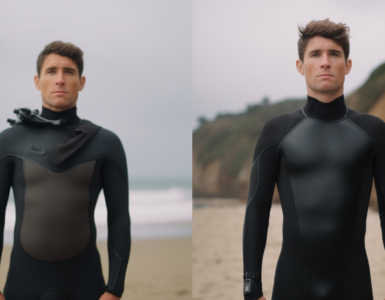Picture this, you’re a water sports enthusiast, and you’re about to dive into your next adventure. But wait! Have you thought about your gear? It’s not just about the surfboard or the jet ski. It’s also about what you wear. The right gear can make a significant difference in your performance and safety. So, if you’re into water sports, you’ve probably heard about wetsuits and dry suits. But what’s the difference? Which one is better? In this post, we’re going to answer these questions and more. So, let’s jump right in!
The Fundamentals of Wetsuits
So, what exactly is a wetsuit? It’s a close-fitting suit made of neoprene, a type of synthetic rubber that provides excellent thermal insulation. Wetsuits work by trapping a thin layer of water between your body and the suit. Your body heat warms up this layer of water, keeping you warm even in cold water. Sounds cool, right? Wetsuits are typically used in activities such as surfing, scuba diving, and other water sports where participants are likely to get wet but want to stay warm.
The Fundamentals of Dry Suits
On the other hand, a dry suit is a bit different. As the name suggests, it’s designed to keep you dry. It’s made from waterproof material and sealed off with watertight zippers and seals around your neck and wrists. But that’s not all. Dry suits also have space for insulating layers underneath, making them perfect for colder water. They are commonly used in professional diving, water rescue operations, and other activities where staying dry and warm is crucial.
The Key Components of a Wetsuit
When you think about a wetsuit, what comes to mind? Maybe it’s the sleek, black design or the snug fit. But have you ever wondered what makes it so effective at what it does? Let’s break it down.
Neoprene: The Material of Choice
Ever heard of neoprene? Chances are, if you’ve worn a wetsuit, you’ve experienced neoprene first-hand. This synthetic rubber is the fundamental material in wetsuits. Why? Because it is excellent at trapping a thin layer of water between the suit and your skin. Your body heat warms this water, creating an insulating barrier against the cold.
Neoprene is also highly flexible and durable, making it perfect for water sports where movement is key. Not to mention, it provides a degree of buoyancy. Pretty neat, right?
Fit and Sizes
When it comes to wetsuits, one size certainly doesn’t fit all. The fit of a wetsuit is crucial for its performance and your comfort. A too loose wetsuit will allow too much water in, making you feel cold. A too tight wetsuit, on the other hand, can limit your movement and make you feel uncomfortable.
Wetsuits come in a range of sizes and styles, from full suits to spring suits and even vests. It’s all about finding the right fit for you and the activity you’re doing.
The Key Components of a Dry Suit
Now, let’s turn our attention to dry suits. While they serve a similar purpose to wetsuits, their design and components are quite different.
Material Varieties
Unlike wetsuits, dry suits are not made from neoprene alone. They can also be made from vulcanized rubber, laminated layers of nylon, or butyl rubber. These materials make dry suits completely waterproof, hence the name dry suit.
Each material has its advantages. For instance, vulcanized rubber is extremely durable, while nylon offers more flexibility. The choice of material often depends on the specific requirements of the activity.
Design and Seals
Dry suits have a unique design feature: seals. The neck and wrist seals prevent water from entering the suit, keeping you completely dry. These seals are typically made of latex or silicone and need to be tight enough to block water but not so tight as to restrict blood flow.
Dry suits also have a waterproof zipper and sometimes even a valve to allow trapped air to escape. These features ensure you stay dry and comfortable during your underwater adventure.
| Component | Wetsuit | Dry Suit |
|---|---|---|
| Material | Neoprene | Vulcanized rubber, nylon, butyl rubber |
| Fit | Snug, multiple sizes and styles | Loose, sealed at the neck and wrists |
| Design Features | Flexible, durable, provides buoyancy | Waterproof, air valve, durable |
When to Use a Wetsuit
Ever wondered about the perfect time to wear a wetsuit? Well, the answer is not as complicated as it might seem. Wetsuits are designed for use in water sports activities where the water temperature is between 45 and 75 degrees Fahrenheit. They are a popular choice for sports like surfing, wakeboarding, and diving in moderately cool waters. The wetsuit’s design allows a thin layer of water to enter, which your body then heats up, providing a warm layer between you and the suit. This makes it ideal for activities where you might be frequently in and out of the water.
When to Use a Dry Suit
On the other hand, dry suits are designed to keep the wearer completely dry, making them perfect for colder water conditions, typically below 45 degrees Fahrenheit. They are commonly used in cold-water scuba diving, paddleboarding, kayaking, and even in professional settings like underwater welding and rescue operations. Dry suits allow for thermal undergarments to be worn underneath, providing an additional layer of insulation. So, if you plan to venture into colder waters or stay submerged for longer periods, a dry suit is your best bet.
When to use each suit:
- Wetsuit: Surfing, Wakeboarding, Diving in moderately cool waters
- Dry Suit: Cold-water Scuba Diving, Paddleboarding, Kayaking, Underwater Welding, Rescue operations
The Maintenance and Care of Wetsuits and Dry Suits
Whether you choose to use a wetsuit or a dry suit, proper maintenance is key to extending their lifespan. Both types of suits need to be cleaned thoroughly after each use, as saltwater, chlorine, and even fresh water can degrade the materials over time. Using a mild detergent and warm water is typically the best method.
When it comes to drying, avoid direct sunlight and opt for a cool, shaded area. Remember, heat can damage the suit’s material. Also, ensure the suit is completely dry before storing it away to prevent mildew or other damage.
Storing your suits properly is just as important. Hang them up on wide, padded hangers or lay them flat, ensuring they aren’t folded or creased. Regularly inspect your suit for any signs of wear and tear, and make minor repairs promptly to prevent further damage. Remember, taking care of your wetsuit or dry suit not only prolongs its life but also ensures it performs at its best when you need it.
Pros and Cons of Wetsuits
Ever wondered why most surfers and divers choose wetsuits? Let’s take a closer look.
On the plus side, wetsuits are generally more affordable than dry suits, making them a great option for beginners and those on a budget. They are also highly flexible, allowing for a wide range of movement, which is vital for sports like surfing and diving. Moreover, wetsuits are durable and can withstand the rigors of regular use in the water.
However, wetsuits are not without their drawbacks. For one, they do not provide as much insulation as dry suits, making them less suitable for cold water conditions. Also, they require a snug fit to work effectively, which some people may find uncomfortable.
Pros and Cons of Dry Suits
So, why would someone opt for a dry suit instead? Let’s explore the pros and cons.
The advantage of dry suits lies in their superior insulation. They are designed to keep you dry and warm, even in very cold water, making them ideal for activities such as deep sea diving or winter watersports. Additionally, they are generally more comfortable to wear, as they allow for layering underneath and do not need to fit as tightly as wetsuits.
On the downside, dry suits are generally more expensive than wetsuits. They also require more maintenance to keep them in good condition. Plus, they can be less durable than wetsuits, particularly if not cared for properly.
- Wetsuits Pros: Affordable, Flexible, Durable
- Wetsuits Cons: Less Insulation, Snug fit can be uncomfortable
- Dry Suits Pros: Superior Insulation, More Comfortable
- Dry Suits Cons: More Expensive, Require more maintenance, Less Durable
Making the Right Choice: Wetsuit or Dry Suit?
In the end, the choice between a wetsuit and a dry suit comes down to your specific needs, preferences, and the conditions in which you’ll be using it. Both have their strengths and weaknesses, and understanding these can help you make the right choice.
So, are you a surfer who needs flexibility and durability? Or are you a deep-sea diver who needs to stay warm in cold conditions? Maybe you’re just a casual swimmer who wants to be comfortable in the water. Whatever your needs may be, we hope this information helps you make an informed decision. Happy swimming!




